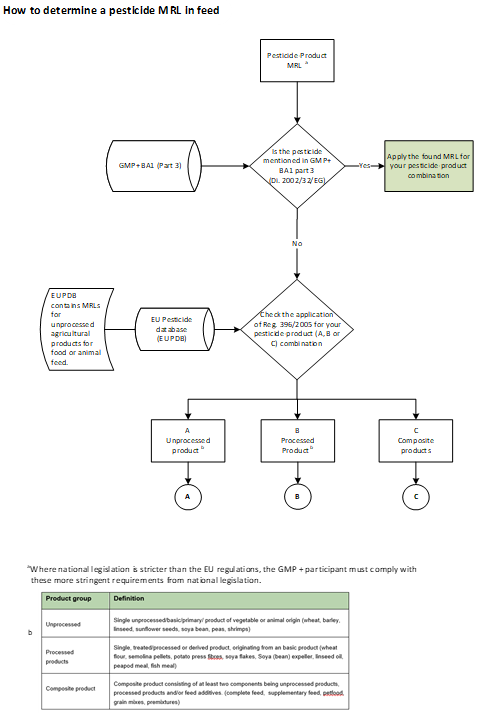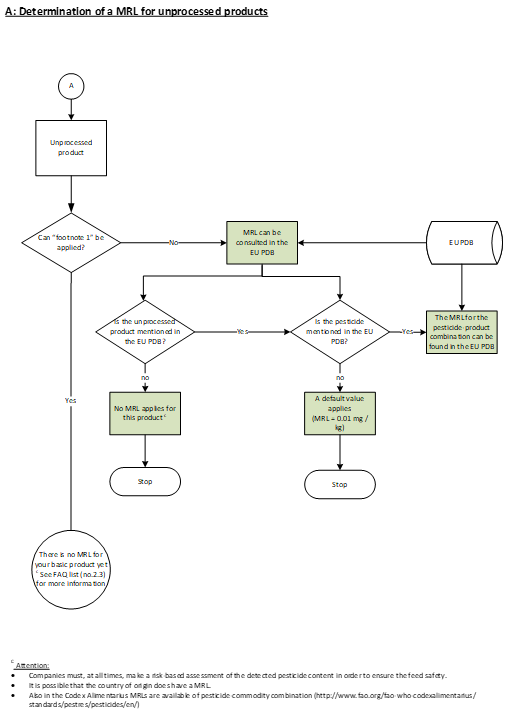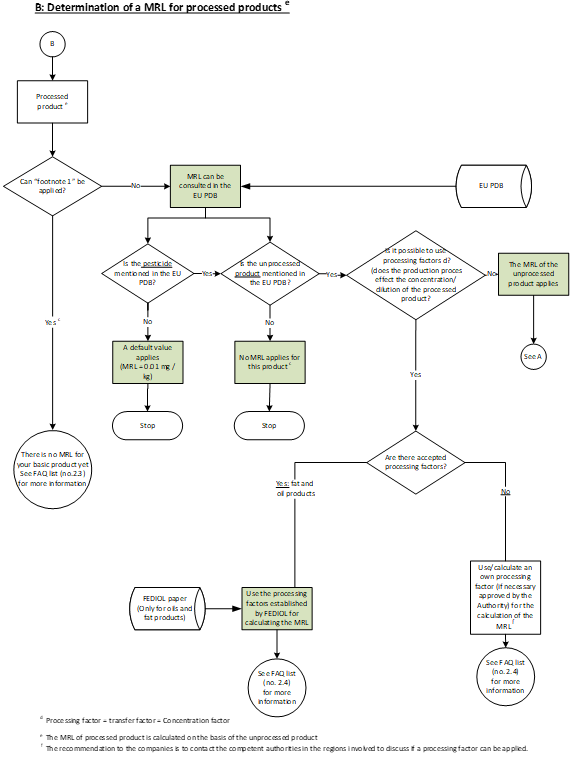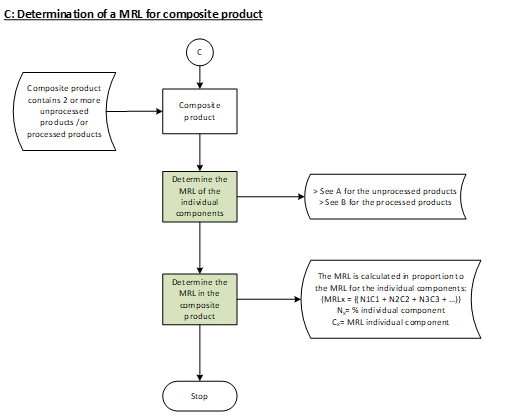1. Introduction
GMP+ International has received questions from its participants about the requirements in the GMP+ FC scheme regarding the applicable Maximum residues level (MRLs) for pesticides in feed. Below, we have described and answered the most frequently asked questions.
The MRLs are based on EU legislation. Unfortunately, in some cases the EU legislation is unclear or the information is not complete. At the same time the authorities in the EU may have different opinions/interpretations of the legislation. Due to these reasons there are difficulties in determining the MRL for pesticides in feed products.
Despite the difficulties mentioned above and with regard to HACCP, a participant must determine - for each Critical Control Point (CCP) - the measuring values in which the safety of the product can be guaranteed. For this purpose, specific feed safety limits for undesirable substances have been established in the GMP+ Feed Certification scheme (GMP+ FC scheme). These limits are included in Appendix 1 of the GMP+ FC scheme: GMP+ BA1 Specific Feed Safety Limits. For pesticides, the limits are based on EU legislations:
- Directive (EC) No. 2002/32: In this directive, the forbidden/prohibited pesticides are included. This is included in part 3 of GMP+ BA1 and
- Regulation (EC) No. 396/2005: in this regulation, the maximum residue levels of pesticides in or on food and feed of plant and animal origin are stated. This is included in part 4 of GMP+ BA1.
Note: The content of this legislation is integrated in the EU Pesticides database (EU PDB).
EU legislation is included in the GMP+ requirements. This means that it applies to all GMP+ participants across the globe *.
Note: when national legislation is stricter than the GMP+ BA1 requirements, the GMP+ participant must respect the requirements of that legislation. GMP+ International advises to communicate with your customers about possible stricter requirements from national legislation. This way, you can take into account the requirements which your product must meet and prevent problems further down the supply chain.
Should you have any further questions or would you like to receive more information, please contact us via our contact form. If needed, this list will be expanded.
2. Questions
2.1. How to determine a pesticide MRL in feed?
In Chapter 4 of the GMP+ TS 1.5 “Specific Feed Safety Limits” is explained how to determine a pesticide MRL in feed.
To help you determine the applicable MRL in feed, GMP+ International developed a decision tree. You can find this decision tree in this document.
Further, a couple of examples of calculations for the MRL product/pesticide combinations have been prepared and presented via the MVO website.
2.2. Which MRL is applicable on not approved/forbidden pesticides in feed products?
There are 2 options:
- the MRL of the forbidden/prohibited pesticides are mentioned in part 3 of GMP+ BA1 Specific Feed Safety Limits. This is in accordance with Directive (EC) No. 2002/32;
- the MRL of the unapproved pesticides can be found in EU Pesticides database. This is in accordance with Regulation (EC) No. 396/2005.
If the pesticides are not mentioned in the EU pesticides database, the default value (default MRL) of 0,01 mg/kg applies.
2.3. In which cases can ‘footnote 1’ be applied?
For a limited number of products the MRLs in Regulation (EC) No. 396/2005 are not yet applicable. This is according to the so-called “footnote 1” *.
The authorities in the EU may have different opinions/interpretations of this legislation.
- The recommendation to the companies is to contact the competent authorities in the regions involved to know how to apply this regulation.
| * The current text of ‘footnote 1’ is: “MRLs do not apply to products or parts of the product used exclusively as ingredients for animal feed, until separate MRLs will be applicable.” This footnote is, at the time of publication of this FAQ list, under revision by the European Commission. The new proposed text is: ‘MRLs do not apply to products or part of products that by their characteristics and nature can be used exclusively as ingredients of animal feed, until separate MRLs are set in the specific category 1200000” |
2.4. Is it allowed to use processing factors (transfer factors)?
Yes, according to the legislation it is allowed but they are not determined. Until now Annex VI of Regulation 396/2005 has not yet been filled out. This annex should contains specific concentration or dilution factors for certain processing processes. But it's still empty.
For fats and oils the International Expert Committee (IEC) has adopted the MVO / FEDIOL approach.
This means the following:
- Use the processing factors in accordance with FEDIOL (where possible/applicable)
- For other products than those mentioned in the “FEDIOL paper” an own processing factor must be calculated/made. Contact your manufacturer and if needed the competent authority to carry out this calculation. Where required, it must be submitted for approval to the competent authority.
- In the absence of a calculation or the inability to apply processing factors, the MRL of the primary/basic/unprocessed product must also be used for the processed product.
GMP+ International advises to communicate with the customers about the application of processing factors.
For more information, consult the MVO website.
2.5. Relevant sources of information about pesticides
The following links to website contain information about pesticides.
- EU Pesticides database (EU PDB)
http://ec.europa.eu/food/plant/pesticides/eu-pesticides-database/public/?event=homepage&language=EN
- FEDIOL paper ‘Establishing processing factors for vegetable oils and fats.
(http://www.fediol.be/data/fediol_11SAF181_3578.pdf)
- MVO: ‘MVO notifying requirements on Pesticides’
(http://www.mvo.nl/mvo-notifying-requirements-on-pesticides)
- The Dutch National Institute for Public Health and the Environment (RIVM) https://chemkap.rivm.nl/en/Topics/C/ChemKAP/Fruit_and_Vegetables/Processing_factors
- The German Federal Institute for Risk Assessment (BfR)
(http://www.bfr.bund.de/cm/349/bfr-data-collection-on-processing-factors.pdf)
- The Belgian FAVV http://www.afsca.be/plantaardigeproductie/gewasbeschermingsmiddelen/_documents/2016_09_12_CalculPSTI_v11.xlsx
- The Pesticides Properties DataBase (PPDB) http://sitem.herts.ac.uk/aeru/ppdb/en/index.htm
Annex 1







